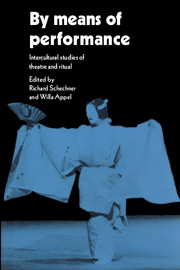Book contents
- Frontmatter
- Contents
- List of figures
- Notes on contributors
- Concerning Victor Turner
- Introduction
- 1 Are there universals of performance in myth, ritual, and drama?
- 2 Magnitudes of performance
- 3 Liminality: a synthesis of subjective and objective experience
- 4 The Yaqui deer dance at Pascua Pueblo, Arizona
- 5 A Yaqui point of view: on Yaqui ceremonies and anthropologists
- 6 Performance of precepts/precepts of performance: Hasidic celebrations of Purim in Brooklyn
- 7 The significance of performance for its audience: an analysis of three Sri Lankan rituals
- 8 What does it mean to “become the character”: power, presence, and transcendence in Asian in-body disciplines of practice
- 9 Korean shamans: role playing through trance possession
- 10 The practice of noh theatre
- 11 The profanation of the sacred in circus clown performances
- 12 Ethnographic notes on sacred and profane performance
- 13 The spatial sense of the sacred in Spanish America and the American South and its tie with performance
- 14 Space and context
- 15 The transformation of consciousness in ritual performances: some thoughts and questions
- 16 Universals of performance; or amortizing play
- Appendix
- Bibliography
- Index
11 - The profanation of the sacred in circus clown performances
Published online by Cambridge University Press: 05 June 2012
- Frontmatter
- Contents
- List of figures
- Notes on contributors
- Concerning Victor Turner
- Introduction
- 1 Are there universals of performance in myth, ritual, and drama?
- 2 Magnitudes of performance
- 3 Liminality: a synthesis of subjective and objective experience
- 4 The Yaqui deer dance at Pascua Pueblo, Arizona
- 5 A Yaqui point of view: on Yaqui ceremonies and anthropologists
- 6 Performance of precepts/precepts of performance: Hasidic celebrations of Purim in Brooklyn
- 7 The significance of performance for its audience: an analysis of three Sri Lankan rituals
- 8 What does it mean to “become the character”: power, presence, and transcendence in Asian in-body disciplines of practice
- 9 Korean shamans: role playing through trance possession
- 10 The practice of noh theatre
- 11 The profanation of the sacred in circus clown performances
- 12 Ethnographic notes on sacred and profane performance
- 13 The spatial sense of the sacred in Spanish America and the American South and its tie with performance
- 14 Space and context
- 15 The transformation of consciousness in ritual performances: some thoughts and questions
- 16 Universals of performance; or amortizing play
- Appendix
- Bibliography
- Index
Summary
The notion of ritual has been put to great use during the last few decades in the disciplines which are founded on the observation of social behavior, both in humans and animals. Ethologists, sociobiologists, sociologists, cultural anthropologists, semioticians and a few others, have found it useful to thus characterize some patterned behavior in face-to-face interactions as well as collective actions. This phenomenon has expectedly generated a certain conceptual confusion in spite of some attempts at integrating these various uses, including the original religious one, within a unified framework in order to establish a posteriori the scientific or philosophical validity of the extension of this notion (e.g., Douglas 1973; d'Aquili 1979). I.M. Lewis (1976: 129–44) has concisely retraced the migrations of this concept first from the domain of religion to ethology, then from ethology to the social sciences in a way which accounts for its current fuzziness if not inconsistency. In addition to the classical definitions propounded by the sociologists of religion (Nisbet 1967: 216–63), we have indeed, at one extreme, the ethologists' technical definition of ritualization as “the process by which non-communicative behavior patterns evolve into communicative ones.” (Eibl-Eibesfeldt 1979: 14); on the other end of the spectrum, the term is used by some anthropologists of theological inclination with a value close to its primitive religious origins (e.g., Douglas 1973; Turner 1974).
- Type
- Chapter
- Information
- By Means of PerformanceIntercultural Studies of Theatre and Ritual, pp. 194 - 207Publisher: Cambridge University PressPrint publication year: 1990
- 5
- Cited by



